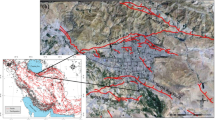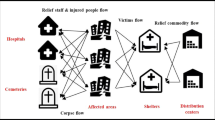Abstract
In this study, we propose a mathematical model and heuristics for solving a multi-period location-allocation problem in post-disaster operations, which takes into account the impact of distribution over the population. Logistics restrictions such as human and financial resources are considered. In addition, a brief review on resilience system models is provided, as well as their connection with quantitative models for post-disaster relief operations. In particular, we highlight how one can improve resilience by means of OR/MS strategies. Then, a simpler resilience schema is proposed, which better reflects an active system for providing humanitarian aid in post-disaster operations, similar to the model focused in this work. The proposed model is non-linear and solved by a decomposition approach: the master level problem is addressed by a non-linear solver, while the slave subproblem is treated as a black-box coupling heuristics and a Variable Neighborhood Descent local search. Computational experiments have been done using several scenarios, and real data from Belo Horizonte city in Brazil.












Similar content being viewed by others
References
Abounacer, R., Rekik, M., & Renaud, J. (2014). An exact solution approach for multi-objective location-transportation problem for disaster response. Computers and Operations Research, 41, 83–93.
Altay, N., & Green, W. G, I. I. I. (2006). OR/MS research in disaster operations management. European Journal of Operational Research, 175(1), 475–493.
Audet, C., & Dennis, J. E, Jr. (2006). Mesh adaptive direct search algorithms for constrained optimization. SIAM Journal on Optimization, 17(1), 188–217.
Balcik, B., Beamon, B. M., & Smilowitz, K. (2008). Last mile distribution in humanitarian relief. Journal of Intelligent Transportation Systems: Technology, Planning, and Operations, 12(2), 51–63.
Berkoune, D., Renaud, J., Rekik, M., & Ruiz, A. (2012). Transportation in disaster response operations. Socio-Economic Planning Sciences, 46, 23–32.
Boin, A., & McConnell, A. (2007). Preparing for critical infrastructure breakdowns: The limits of crisis management and the need for resilience. Journal of Contingencies and Crisis Management, 15(1), 50–59.
Bruneau, M., Eeri, A., Chang, S., Eeri, B., Ronald, T., Eeri, C., et al. (2003). A framework to quantitatively assess and enhance the seismic resilience of communities. Earthquake Spectra, 19, 733–752.
Bruneau, M., & Reinhorn, A. (2007). Exploring the concept of seismic resilience for acute care facilities. Earthquake Spectra, 23(1), 41–62.
Caunhye, A. M., Nie, X., & Pokharel, S. (2012). Optimization models in emergency logistics: A literature review. Socio-Economic Planning Sciences, 46(1), 4–13. (Special Issue: Disaster Planning and Logistics: Part 1).
Diaz, R., Behr, J., Toba, A. L., Giles, B., Ng, M., Longo, F., et al. (2013). Humanitarian/emergency logistics models: A state of the art overview. In Proceedings of the 2013 Summer Computer Simulation Conference, SCSC ’13 (pp. 1–8). Society for Modeling & Simulation International, Vista, CA.
Francis, R., & Bekera, B. (2014). Resilience analysis for engineered and infrastructure systems under deep uncertainty or emergent conditions. Reliability Engineering and System Safety, 121, 90–103.
Haimes, Y. Y. (2009). On the definition of resilience in systems. Risk Analysis, 29(4), 498–501.
Hanson, B., & Roberts, L. (2005). Resiliency in the face of disaster. Science, 309(5737), 1029.
Holling, C. (1973). Resilience and stability of ecological systems. Annual Review of Ecology and Systematics, 4(1), 1–23.
Horner, M. W., & Downs, J. A. (2010). Optimizing hurricane disaster relief goods distribution: Model development and application with respect to planning strategies. Disasters, 34(3), 821–844.
Huachi, P., Santos, A. C., & Prins, C. (2015). Solving multiple depot heterogeneous fleet vehicle routing problems for post disaster relief. In Proceedings of the 6th international triennial workshop on Freight Transportation and Logistics, Odysseus 2015 (p. 4p). Ajaccio, France.
Huang, M., Smilowitz, K., & Balcik, B. (2012). Models for relief routing: Equity, efficiency and efficacy. Transportation Research Part E: Logistics and Transportation Review, 48(1), 2–18.
Huang, R., Kim, S., & Menezes, M. (2010). Facility location for large-scale emergencies. Annals of Operations Research, 181(1), 271–286.
Jia, H., Ordóñez, F., & Dessouky, M. (2007). A modeling framework for facility location of medical services for large-scale emergencies. IIE Transactions on Homeland Security, 39(1), 41–55.
Jia, H., Ordóñez, F., & Dessouky, M. (2007). Solution approaches for facility location of medical supplies for large-scale emergencies. Computers and Industrial Engineering, 52(2), 257–276.
Le Digabel, S. (2011). Algorithm 909: NOMAD: Nonlinear optimization with the MADS algorithm. ACM Transactions on Mathematical Software, 37(4), 1–15.
Liberatore, F., Ortuño, M., Tirado, G., Vitoriano, B., & Scaparra, M. (2014). A hierarchical compromise model for the joint optimization of recovery operations and distribution of emergency goods in humanitarian logistics. Computers and Operations Research, 42, 3–13.
Manyena, S. (2006). The concept of resilience revisited. Disasters, 30(4), 434–450.
Mezzou, O., Birregah, B., & Châtelet, E. (2011). A theoretical study of the interactions between the components of resilience in critical urban infrastructures. In IET international conference on smart and sustainable city (ICSSC 2011) (pp. 1–6).
Mladenovic, N., & Hansen, P. (1997). Variable neighborhood search. Computers and Operations Research, 24(11), 1097–1100.
Murat, H., Prins, C., & Santos, A. (2014). Exact and heuristic algorithms for solving the generalized vehicle routing problem with flexible fleet size. International Transactions in Operational Research, 21(1), 153–175.
Nolz, P., Doerner, K., Gutjahr, W., & Hartl, R. (2010). A bi-objective metaheuristic for disaster relief operation planning. In C. C. Coello, C. Dhaenens, & L. Jourdan (Eds.), Advances in multi-objective nature inspired computing. Studies in computational intelligence (Vol. 272, pp. 167–187). Berlin: Springer.
Ortuño, M. T., Cristóbal, P., Ferrer, J. M., Martín-Campo, F. J., Muñoz, S., Tirado, G., et al. (2013). Decision aid models and systems for humanitarian logistics. A survey. In B. Vitoriano, J. Montero, & D. Ruan (Eds.), Decision aid models for disaster management and emergencies. Atlantis computational intelligence systems (Vol. 7, pp. 17–44). amsterdam: Atlantis Press.
Prins, C., Santos, A., & Afsar, H. (2012). Splitting procedure and a relaxed iterated local search for the generalized vehicle routing problem. In Procedings of the Latino-Iberoamericano de Investigación Operativa, Simpósio Brasileiro de Pesquisa Operacional, CLAIO-SBPO. Rio de Janeiro, Brazil.
Rath, S., & Gutjahr, W. J. (2014). A math-heuristic for the warehouse location-routing problem in disaster relief. Computers and Operations Research, 42, 25–39.
Rekik, M., Ruiz, A., Renaud, J., Berkoune, D., & Paquet, S. (2013). A decision support system for humanitarian network design and distribution operations. In V. Zeimpekis, S. Ichoua, & I. Minis (Eds.), Humanitarian and relief logistics. Operations research/computer science interfaces series (Vol. 54, pp. 1–20). New York: Springer.
Rottkemper, B., Fischer, K., & Blecken, A. (2012). A transshipment model for distribution and inventory relocation under uncertainty in humanitarian operations. Socio-Economic Planning Sciences, 46, 98–109.
Sheu, J. B. (2010). Dynamic relief-demand management for emergency logistics operations under large-scale disasters. Transportation Research Part E: Logistics and Transportation Review, 46(1), 1–17.
Tzeng, G. H., Cheng, H. J., & Huang, T. D. (2007). Multi-objective optimal planning for designing relief delivery systems. Transportation Research Part E: Logistics and Transportation Review, 43(6), 673–686.
Vitoriano, B., Ortuño, M. T., Tirado, G., & Montero, J. (2011). A multi-criteria optimization model for humanitarian aid distribution. Journal of Global Optimization, 51(2), 189–208.
Acknowledgments
This work was supported by grants from the CSFRS (Conseil Supérieur de la Formation et de la Recherche Stratégiques, France) and from the PST Résilience et Gestion de Crise at the UTT, France.
Author information
Authors and Affiliations
Corresponding author
Rights and permissions
About this article
Cite this article
Duhamel, C., Santos, A.C., Brasil, D. et al. Connecting a population dynamic model with a multi-period location-allocation problem for post-disaster relief operations. Ann Oper Res 247, 693–713 (2016). https://doi.org/10.1007/s10479-015-2104-1
Published:
Issue Date:
DOI: https://doi.org/10.1007/s10479-015-2104-1




